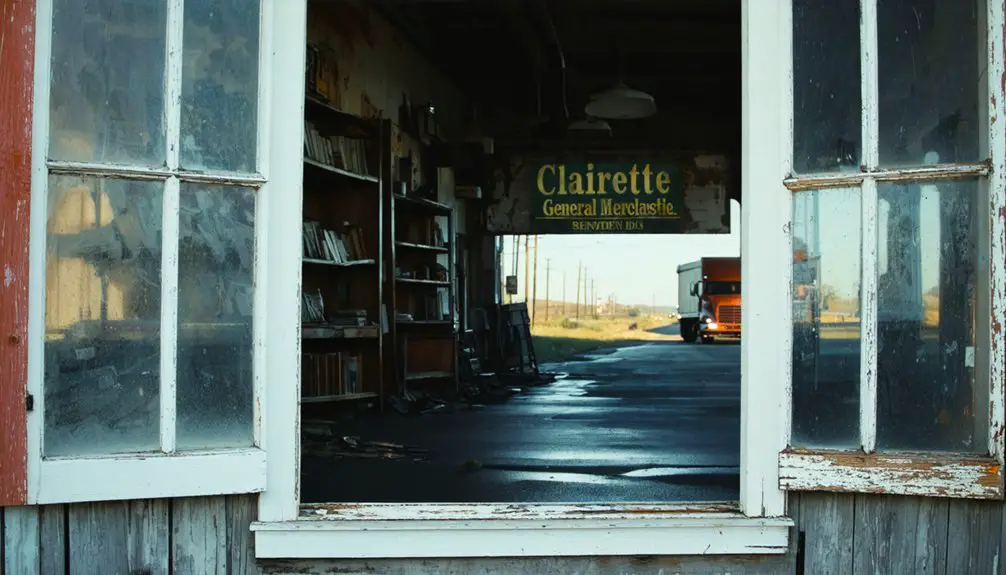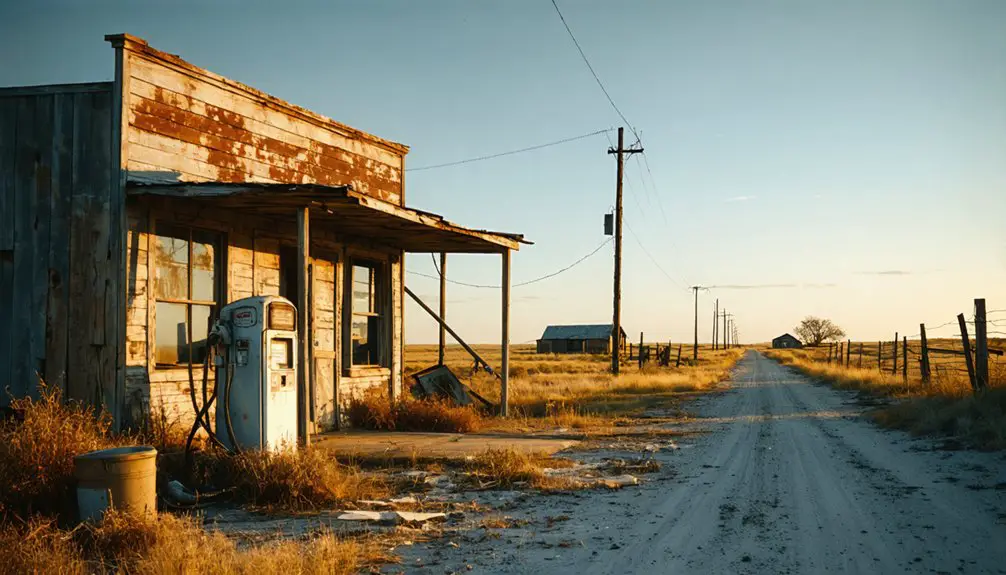You’ll find Clairette, Texas along the Bosque River in Erath County, where it emerged as a strategic railroad stop in the 1880s. The town, named after a popular soap brand, flourished with the Texas Central line and reached its peak of 300 residents by 1940. After the Katy Railroad’s abandonment in the late 1960s, Clairette’s population dwindled to about 60. Today, remnants of its rail-era buildings and the old schoolhouse tell a deeper story of rural Texas transformation.
Key Takeaways
- Clairette reached its peak population of 300 in 1940 but declined to just 60 residents by the 1970s following railroad abandonment.
- The town was established in the 1880s as a strategic railroad stop along the Texas Central line.
- The closure of the Katy Railroad branch in the late 1960s triggered major demographic shifts and business closures.
- Current residents must commute to nearby cities like Hico or Dublin for basic services and employment.
- Historical remnants include an early 20th-century schoolhouse, cemetery, abandoned houses, and preserved structures with educational markers.
The Rise of a Railroad Town (1880s)
When the Texas Central line began construction in the 1880s, Clairette emerged as one of many strategic railroad stops between Waco and Stamford. The railroad’s significance transformed this patch of Erath County into a bustling settlement, drawing settlers and entrepreneurs who saw opportunity in the region’s expanding rail network.
You’ll find Clairette’s story typical of Texas railroad towns, where the iron horse brought immediate growth and liveliness. The town’s population swelled to 300 as the community impact of rail service created new possibilities for commerce and connectivity. Like many locations listed in disambiguation pages, Clairette’s name carried different meanings depending on the historical context. The town actually received its name from a popular soap brand of the era.
Situated perfectly along the Bosque River and what would become State Highway 6, Clairette capitalized on its transport advantages. The Katy Railroad’s additional branch from De Leon to Cross Plains further cemented the area’s importance in regional trade routes.
Origins Behind the Unique Name
The peculiar origins of Clairette’s name stand apart from typical Texas town naming conventions of the 1880s.
While most railroad towns adopted names from settlers, geographic features, or Native American terms, Clairette drew its identity from a popular soap brand of the era.
This unique cultural imprint reflected the growing influence of consumer products on rural communities during Texas’s railway expansion.
Much like how disambiguation pages help differentiate between similar place names today, the distinct commercial origin of Clairette’s name helped avoid confusion with other Texas settlements.
Like other Texas towns such as Dime Box, Clairette’s unique name origin became part of local folklore.
- The soap brand’s prominence provided instant recognition for travelers and railway workers
- Unlike neighboring towns named for families or local landmarks
- Historical records consistently confirm the commercial origin
- The name persisted even after the product’s discontinuation
You’ll find this commercial naming origin particularly fascinating, as it’s one of the rare instances where a Texas town derived its identity from a consumer product rather than traditional sources.
Peak Years and Population Growth
Clairette’s rise from a small railway stop to a bustling community paralleled the expansion of Texas’s railroad network in the 1880s.
You’ll find that by 1940, the town reached its zenith with nearly 300 residents, multiple thriving businesses, and several churches serving the community.
The town’s prosperity stemmed from its strategic location along the Texas Central line, connecting the Waco area to Stamford.
Cultural influences shaped the community through regular gatherings at the local churches and community hall.
You’d have witnessed a vibrant rural economy driven by agriculture and rail commerce during these peak years.
Like other towns such as Longfellow Railway Station, Clairette’s identity was fundamentally tied to its role as a transportation hub.
The post office served as an essential hub, while the town’s position near the Bosque River and along Texas State Highway 6 made it an attractive settlement for families seeking opportunities in the region.
Transportation Hub and Local Commerce
Situated strategically along Texas State Highway 6, you’d find Clairette serving as an important transportation nexus during its heyday, connecting southeastern Erath County to wider regional commerce.
The town’s transportation evolution from rail to road dramatically shaped its destiny, with the Texas Central Railroad initially driving growth until its abandonment in the late 1960s. The old schoolhouse building remained a constant landmark through these changes, standing since 1912.
- You could’ve found about five thriving businesses by 1940, serving roughly 275 residents.
- The post office acted as a significant communication hub for local commerce.
- Rail service through the Katy Railroad provided essential passenger and freight connections.
- Highway improvements ultimately led to commerce decline as residents could easily commute to larger towns.
The shift from rail dependency to highway transit marked Clairette’s transformation from a bustling hub to a quieter waypoint.
The Katy Railroad’s Vital Role
You’ll find that Clairette’s story begins with the Texas Central line of the Katy Railroad, which established the town in the 1880s during its expansion from Waco to Stamford.
The railroad transformed Clairette into a bustling transportation hub, helping the community grow to 300 residents at its peak through robust agricultural shipping and passenger service. Following the pattern of other Katy-built towns, Clairette became part of the company’s Gateway to Texas network. The railroad’s ability to efficiently transport ice-refrigerated beef revolutionized shipping capabilities for the region.
When the Katy abandoned its tracks through Clairette in the late 1960s, the town’s population plummeted to about 60 residents by the 1970s, marking the end of its railroad-driven prosperity.
Railroad Drives Early Growth
The arrival of the Katy Railroad‘s Texas Central line in the 1880s transformed Clairette from open rangeland into a bustling frontier settlement.
You’ll find the railroad’s significance woven into every aspect of Clairette’s early commerce, as the town emerged specifically because of this essential transportation link. The Texas Central line connected you directly to major markets in Waco and Stamford, while a strategic branch stretched to Cross Plains. Today, the Red River Railroad Museum preserves vital historical records of the Katy’s operations in Texas. The railroad faced significant challenges early on due to sparse population and limited traffic in the region.
- Eastern capitalists funded the railroad’s expansion through land grants
- Population swelled to 300 as settlers and merchants flocked to the new rail hub
- Agricultural products and cattle shipments became the economic backbone
- Services and businesses sprouted up to support train operations and travelers
Track Removal Sparks Decline
When Katy Railroad abandoned its tracks through Clairette in the late 1960s, the town’s crucial transportation artery was severed, triggering a devastating decline.
You would’ve witnessed the town’s population plummet from 300 to just 60 residents as track abandonment left Clairette cut off from essential regional commerce networks.
The economic isolation hit hard – businesses shuttered, jobs vanished, and rail-dependent industries relocated.
While you could still reach larger towns via the newly improved US Highway 281 and Texas State Highway 6, the flexible road transport couldn’t replace what the railroad had meant for local prosperity.
The town that you’d once known as a bustling rail stop became a shadow of itself, with remaining residents forced to commute elsewhere for work.
Economic Changes and Rural Migration
Like many rural communities dependent on rail transportation, Clairette’s economic decline began in earnest during the late 1960s after the Katy Railroad abandoned its local line.
Without rail service, the town’s economic viability quickly diminished, triggering a wave of rural outmigration as residents sought better opportunities elsewhere.
You’ll find this pattern repeated across Texas, where over 1,000 ghost towns tell similar stories of economic transformation.
- Population plummeted from 300 residents during the town’s peak to around 60 by the 1970s
- Local businesses lost critical freight and passenger access
- Younger residents moved to larger cities offering diverse employment
- Remaining population aged, creating a downward spiral of declining services and opportunities
The town’s story reflects broader economic shifts affecting rural Texas communities during the mid-20th century.
Impact of Highway Development

The construction of U.S. Highway 281 in the mid-20th century dramatically altered Clairette’s role as a transportation hub by redirecting traffic flow away from the town’s center.
You’ll find that this new highway, combined with the improved State Highway 6, enabled residents to bypass Clairette entirely while traveling to larger commercial centers like Hico and Dublin.
The shifting travel patterns ultimately contributed to Clairette’s economic decline, as businesses once sustained by local traffic and the Katy Railroad lost their customer base to establishments along the new highway corridors.
Highway 281’s Economic Effect
Since its development, US Highway 281 has emerged as a critical economic artery, supporting nearly 26,000 freight-intensive businesses and facilitating the movement of 37 million tons of freight valued at $90 billion annually.
The highway’s economic revitalization efforts have transformed regional commerce, creating robust freight transportation networks that connect growing markets.
- You’ll find nearly 465,000 jobs supported by the corridor in sectors like farming, chemicals, and warehousing.
- The highway serves a market area of over 600,000 people, with population growth rates of 1.9%.
- Major commodities moved include farm products (15%), nonmetallic minerals (13%), and chemicals (11%).
- Recent $13.3 million investments in north Edinburg have upgraded the highway to meet federal interstate standards.
This essential infrastructure continues to drive economic expansion, connecting Texas communities to broader market opportunities.
Shifting Travel Patterns
As new highways emerged across rural Texas in the mid-20th century, Clairette’s transportation landscape underwent dramatic changes that would seal its fate.
You’ll find the most significant shift occurred when State Highway 6 improved connectivity to larger towns like Hico and Dublin, fundamentally altering local travel dynamics. The enhanced road network meant you could easily bypass Clairette for better-equipped destinations.
When the Katy Railroad abandoned its local service in the late 1960s, the town’s role as a transportation hub vanished.
Instead of stopping in Clairette, travelers chose routes through communities offering highway-centered amenities. These connectivity shifts meant local residents increasingly commuted elsewhere for work and shopping, while passing motorists had little reason to pause in the dwindling community.
Transportation Hub Decline
While Clairette once thrived as an essential transportation hub during the railroad era, major highway developments in the 1950s and 1960s fundamentally altered its connectivity significance.
The changes in transportation infrastructure reshaped community dynamics, leading to Clairette’s gradual decline. The construction of US Highway 281 and improvements to State Highway 6 redirected regional traffic flows, bypassing the town entirely.
- The Katy Railroad’s abandonment in the late 1960s eliminated crucial rail connectivity
- New highways encouraged commuting to larger towns like Hico and Dublin
- Local businesses closed as transport-related commerce diminished
- Population plummeted from 300 to 55 as the town lost its transportation hub status
These shifts transformed Clairette from a bustling rail stop into an unincorporated community largely dependent on neighboring urban centers.
From Bustling Stop to Silent Streets

During the 1880s, Clairette emerged as a vibrant stop along the Texas Central line, where nearly 300 residents built their lives around the promising railway connection between Waco and Stamford.
Railroad nostalgia runs deep here, as you’ll find remnants of what was once a bustling community centered on the Katy Railroad‘s regular rhythms.
When the railroad abandoned the line in the late 1960s, Clairette’s community resilience was tested.
You’ll see how improved highways, particularly US 281 and State Highway 6, ironically accelerated the town’s decline by making it easier for residents to seek opportunities elsewhere.
The population dwindled to about 60, and the once-energetic streets fell silent.
Today, you’ll discover a quiet reflection of how changing transportation patterns can reshape rural Texas communities.
Preserving Clairette’s Historical Legacy
Local preservation efforts have transformed Clairette into more than just another abandoned railroad stop, thanks to dedicated historical societies and community volunteers who maintain its remaining structures.
You’ll find strong community engagement through regular heritage celebrations and preservation initiatives that keep Clairette’s story alive for future generations.
- Historical societies document the town’s legacy through photographs, maps, and oral histories from descendants of original settlers.
- Architectural preservation focuses on stabilizing railroad structures and historic buildings using authentic materials.
- Educational programs include walking tours, informational signage, and virtual exhibits.
- Heritage tourism efforts balance economic development with maintaining the site’s historical integrity.
Today, you can explore Clairette’s past through archived records, restored landmarks, and interactive educational resources that showcase this unique piece of Texas railroad history.
Modern Day Ghost Town Status
If you visit Clairette today, you’ll find a near-abandoned settlement with fewer than 50 residents occupying what remains of this former rail town’s buildings and homes.
The surviving structures, which stand as remnants of Clairette’s railroad heyday, have largely fallen into disuse since the Katy Railroad’s departure in the late 1960s.
Without any significant commercial activity or municipal services, Clairette now exists primarily as an unincorporated ghost town alongside Texas State Highway 6, where commuter traffic passes by en route to larger neighboring communities.
Current Population Status
Today’s Clairette stands as a sparsely populated ghost town, maintaining a consistent population between 55-60 residents since the 1970s.
The town’s population dynamics reflect a significant decline from its peak of 300 residents during the early 20th century railroad era.
With minimal civic infrastructure and no post office, you’ll find a community that’s adapted to its unincorporated status within Erath County.
- Population hasn’t exceeded 60 residents since the 1970s decline
- Loss of the Katy Railroad in the late 1960s triggered major demographic shifts
- Improved highways and nearby urban centers draw residents away
- Current residents form a small cluster rather than an active town population
The steady, low population numbers confirm Clairette’s classification as a ghost town, characterized by minimal inhabitance rather than complete abandonment.
Physical Structures Remaining
Physical remnants of Clairette’s once-thriving community paint a stark portrait of abandonment, with the early 20th-century schoolhouse standing as the most prominent surviving structure.
You’ll find historical markers that outline the town’s founding, alongside a small cemetery where weathered headstones tell tales of former residents.
Several abandoned houses dot the landscape, their roofless frames and crumbling walls slowly succumbing to nature’s reclamation.
The town’s original layout remains visible through overgrown road alignments, though the rail lines that once brought life to Clairette have long since vanished.
Foundations of homes and businesses peek through thick vegetation, while scattered debris and building materials mark where structures once stood.
No maintained buildings or modern improvements exist within the townsite today.
Present Economic Activities
While the abandoned structures of Clairette stand as silent witnesses to its past, the town’s economic pulse continues to beat faintly through its remaining population of about 60 residents.
Today’s Clairette exemplifies the shift from a self-contained community to a bedroom settlement, where local employment has given way to modern commuting patterns.
- Most residents now drive to nearby Hico or Dublin for work, shopping, and services via Highway 6.
- The former railroad town offers no significant commercial activities or business operations.
- Surrounding rural lands support limited agricultural activities, mostly small-scale farming or ranching.
- The town lacks basic services like stores or gas stations, requiring residents to rely on neighboring communities.
Frequently Asked Questions
Are There Any Original Buildings Still Standing in Clairette Today?
You’ll find only one significant original structure still standing: the 1912 stone schoolhouse with its distinctive Tuscan-columned porch, while other architectural styles from Clairette’s heyday have vanished into history.
What Natural Disasters or Significant Events Affected Clairette’s Development?
Like a Netflix series gone wrong, you won’t find major natural disasters wreaking havoc here. Instead, the town’s fate was sealed by economic decline after losing its railroad, not flood damage or catastrophes.
Who Were Some Notable Residents or Business Owners in Clairette?
While railroad officials and early business owners shaped the town’s beginnings, you’ll find records show general store merchants, cotton traders, and school teachers were among Clairette’s notable residents through its peak years.
Did Clairette Have Its Own School System During Its Peak Years?
Like tracks that vanish into the horizon, Clairette’s school history remains unclear. While you’d expect a town of 300 to have had schooling, there’s no concrete evidence of its educational impact.
What Artifacts or Historical Items Have Been Recovered From Clairette?
You’ll find railroad artifacts like Katy line spikes and ties, household items including soap-brand materials, building foundations, and personal effects that reveal the historical context of daily life from 1880-1950.
References
- https://en.wikipedia.org/wiki/Clairette
- https://en.wikipedia.org/wiki/List_of_ghost_towns_in_Texas
- http://www.texasescapes.com/TexasGhostTowns/Clairemont-Texas.htm
- https://urbexunderground.com/ghost-towns-in-texas/
- https://www.ghosttowns.com/states/tx/tx.html
- https://www.texasescapes.com/TOWNS/Texas-Ghost-Towns-2-Central-Texas.htm
- https://www.youtube.com/watch?v=DRn0IjjUpOw
- https://mix931fm.com/10-texas-ghost-towns/
- https://www.youtube.com/watch?v=phjUE19A8HM
- https://discover.texasrealfood.com/truly-texan/abandoned-ghost-towns-in-texas



